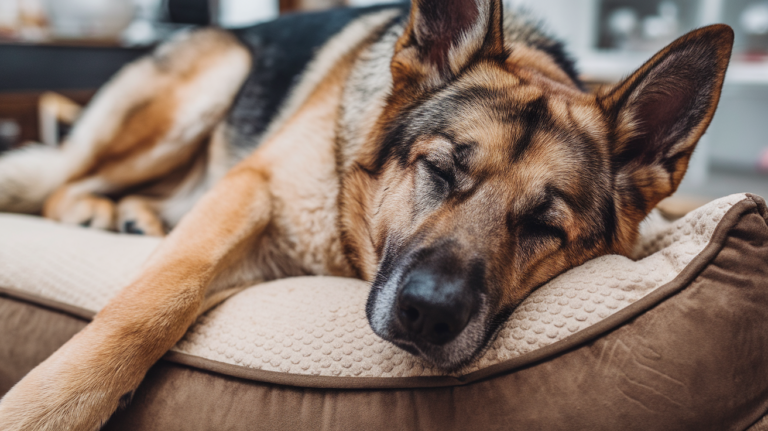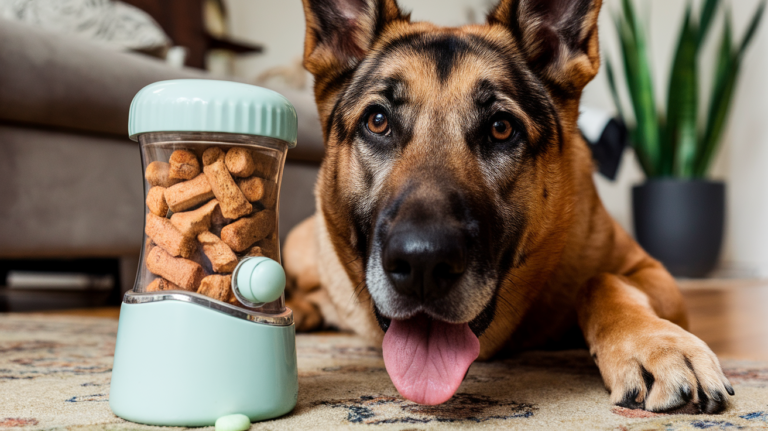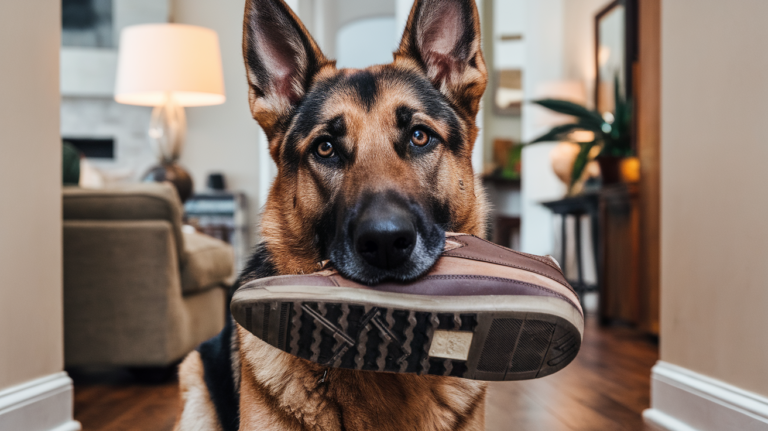Training a German Shepherd to walk calmly on a leash is essential for both the safety of your dog and others around you. These intelligent and energetic dogs can easily become overly excited or distracted, leading to uncontrolled pulling during walks.
However, with patience, consistency, and the right techniques, you can teach your furry companion to walk politely by your side.
Follow these steps to achieve a more enjoyable and stress-free walking experience for both you and your German Shepherd.
1: Choose the Right Equipment
Before embarking on your training journey, it’s crucial to have the appropriate tools at your disposal. A well-fitted harness is often more effective than a collar for leash training, as it distributes pressure evenly across your German Shepherd’s body, discouraging pulling and promoting a more controlled walk.
Consider investing in a harness with a front clip, which encourages your dog to stay closer to you and makes it easier to redirect their attention when necessary.
Additionally, a non-retractable, four to six-foot leash provides better control and feedback during the training process. Retractable leashes can often contribute to inconsistent leash tension and reinforce pulling behavior.
With a fixed-length leash, your German Shepherd will quickly learn that pulling won’t get them anywhere, and walking calmly by your side is the most rewarding option.
Finally, equipping yourself with an ample supply of small, highly-motivating treats is essential for positive reinforcement during your walks.
German Shepherds are highly food-motivated, and using their favorite treats as rewards will help reinforce the desired behavior and make the training process more enjoyable for your furry companion.
2: Establish a Cue
Before you can begin teaching your German Shepherd to walk calmly on a leash, you’ll need to establish a specific cue that signals it’s time to start walking. This could be a verbal command like “let’s go!” or a simple click from a training clicker.
Whatever cue you choose, it’s essential to practice it consistently in a controlled environment, such as your backyard or a quiet room in your home.
Start by holding the leash and giving the cue, then reward your German Shepherd with a treat when they begin walking beside you. This repetition will help them associate the cue with the action of walking calmly by your side.
As your dog becomes more consistent in responding to the cue, you can gradually increase the distance you walk and the duration of your training sessions.
3: Practice in a Low-Distraction Environment
Once your German Shepherd has mastered the basic cue and understands the concept of walking beside you, it’s time to begin leash training in a quiet area with minimal distractions.
This controlled environment will ensure that your dog can focus on you and the task at hand without being overwhelmed by external stimuli.
Start by walking short distances, using your cue word and rewarding your dog frequently for walking at your side without pulling. The goal is to build up their confidence and understanding in a controlled setting before moving on to more challenging environments.
During these initial training sessions, be patient and consistent. If your German Shepherd becomes distracted or starts to pull, simply stop walking, and wait until they return to your side or the leash slackens before continuing.
This will help reinforce the idea that pulling won’t get them where they want to go, and walking calmly by your side is the most rewarding option.
4: Employ the “Stop and Go” Method
One of the most effective techniques to discourage pulling is the “Stop and Go” method. If your German Shepherd begins to pull during your walk, immediately stop walking and stand still. Wait patiently until they return to your side or the leash slackens, then continue walking.
This method teaches your dog that pulling won’t get them where they want to go, and that walking calmly by your side is the more rewarding behavior.
Consistency is key; ensure that everyone who walks your German Shepherd follows this same method to avoid confusion and mixed signals.
As your dog begins to understand the “Stop and Go” technique, you can gradually increase the duration of your stops, making it clear that pulling will only result in a longer pause in your walk.
However, it’s important to remain patient and not become frustrated, as this can undermine the training process and create a negative association with leash walking.
5: Use Positive Reinforcement
Positive reinforcement is a crucial component of successful leash training. When your German Shepherd walks without pulling, be sure to praise them enthusiastically and offer a treat.
The timing of the reward is vital – make sure it’s immediately after the desired behavior to create a strong connection in your dog’s mind.
Over time, your German Shepherd will learn that walking calmly beside you results in positive outcomes, such as tasty treats, verbal praise, and the ability to continue moving forward.
This positive association will reinforce the desired behavior and make leash walking a more enjoyable experience for both you and your furry companion.
It’s important to note that positive reinforcement should be consistent and tailored to your individual dog’s preferences.
Some German Shepherds may be more motivated by food treats, while others may respond better to verbal praise or a favorite toy. Experiment and find what works best for your dog to ensure the training process is as effective and rewarding as possible.
6: Gradually Increase Distractions
Once your German Shepherd consistently walks without pulling in a low-distraction environment, it’s time to gradually introduce more challenging situations.
This could include busier streets with higher levels of pedestrian and vehicle traffic, areas with other dogs, or public parks where there are plenty of sights, sounds, and smells to capture your dog’s attention.
Start with less challenging distractions and progressively increase the difficulty as your dog becomes more confident and responsive.
Continue to use the “Stop and Go” method and positive reinforcement to guide your dog’s behavior in these more stimulating environments.
It’s important to be patient and manage your expectations during this phase of training. Your German Shepherd may experience setbacks or become overwhelmed in highly distracting situations.
If this occurs, simply return to a lower-distraction environment and continue reinforcing the desired behavior before attempting more challenging scenarios.
7: Incorporate Regular Training Sessions
Regular, short training sessions are more effective than sporadic, long ones when it comes to teaching your German Shepherd to walk calmly on a leash. Aim for daily walks where you can consistently practice and reinforce leash manners.
Patience and persistence are essential during the training process. Remember, leash training is a gradual process, and each dog learns at their own pace. Celebrate small victories along the way and remain committed to reinforcing good behavior.
As your German Shepherd’s leash walking skills improve, you can gradually increase the duration of your walks and the level of distractions you encounter. However, it’s important to maintain a consistent training routine to solidify the desired behavior and prevent regression.
8: Maintain Consistency Across Handlers
Consistency is crucial not just in the training methods you use but also among all family members or anyone else who walks your German Shepherd. Ensure that everyone is using the same commands, cues, and techniques when it comes to leash training.
Inconsistent training approaches can confuse your dog, making it harder for them to learn and maintain the expected behavior.
Establish clear guidelines and communicate regularly with anyone involved in your German Shepherd’s care to ensure a unified approach to leash training.
It’s also important to be patient and understanding if your dog exhibits slight behavioral differences with different handlers. German Shepherds are highly perceptive and may respond differently to different personalities and energy levels.
As long as everyone is following the same basic principles, your dog will eventually learn to walk calmly on a leash regardless of who is holding the leash.






